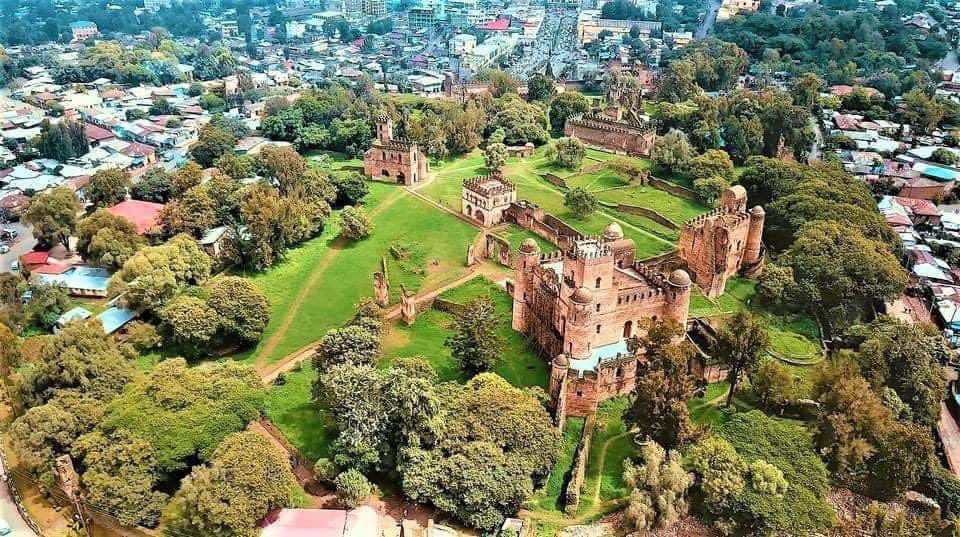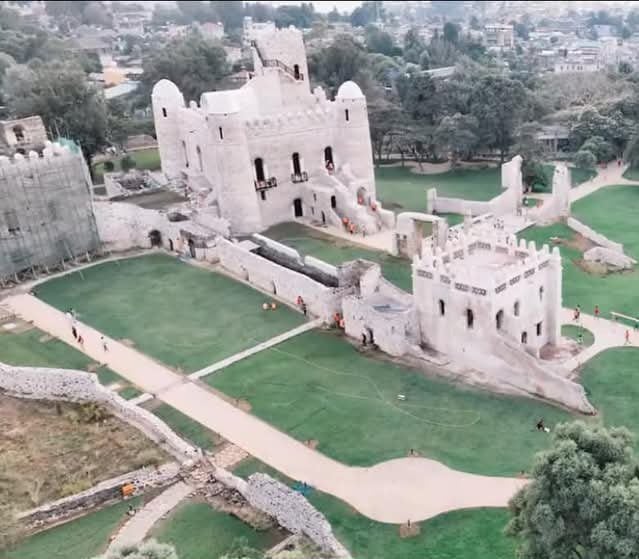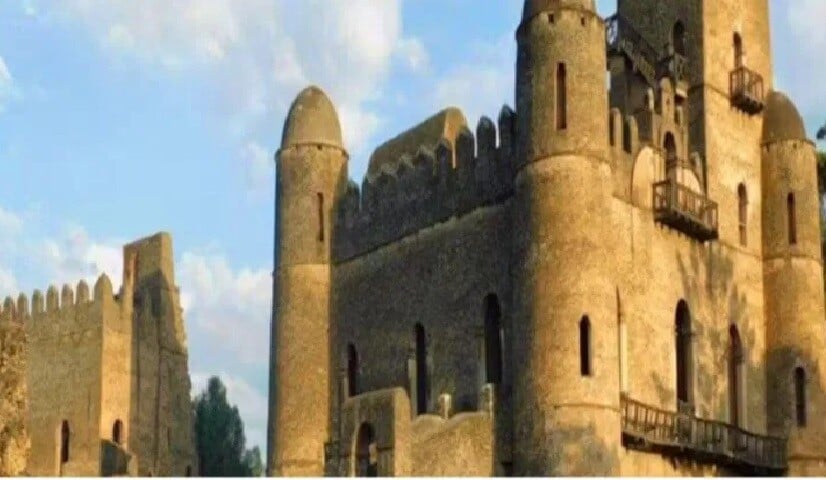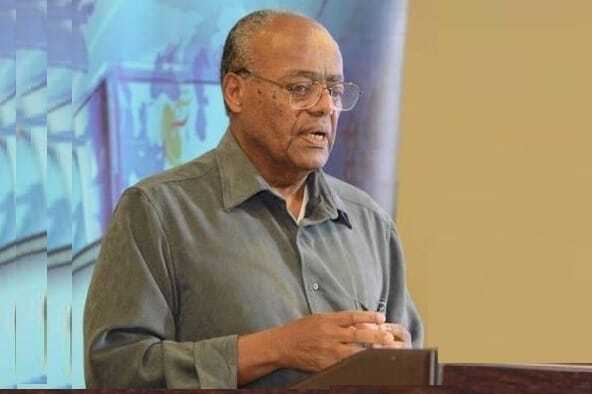(The Habesha) – In the realm of historical preservation, the line between restoration and innovation can often be blurred. This is especially true with the recent reconstruction of Gonder Castle orchestrated by Abiy Ahmed. As we embark on this discussion, the question at the heart of the matter is how far should restoration efforts go before historical sites lose their original cachet? Do we risk erasing precious historical imprints of time by peppering them excessively with modern renovations and restorations? This discussion delves into the tricky nuances of preserving history, examining the controversial changes applied to Gonder Castle as we navigate the topsy-turvy terrain of historical conservation.

Overview of Gonder Castle Restoration
Introduction and discussions around the restoration of such extensively significant historical sites like the Gonder Castle bring up both excitement and apprehension. The depth and complexity of the site’s history make the process quite compelling, yet very intricate. This section will aim to demystify the subject, shedding light on both the Gonder Castle itself and what motivated its restoration.
Introduction to Gonder Castle
Significance of Gonder Castle
Gonder Castle, a world heritage site located in Northern Ethiopia, is a place of immense historic, cultural, and architectural significance. Often referred to as the “Camelot of Africa,” the castle embodies Ethiopia’s sagacious past, hosting a series of royal structures built in the 17th and 18th centuries by Emperor Fasilides and his descendants. Wandering through its stone halls, one can still sense the echoes of the bustling court life, diplomatic encounters, and fateful decisions that reverberated through its corridors. These testimonies bestow on the castle an irreplaceable value, making its conservation imperative for generations to come.
Historical Background

Gonder Castle was the center stage for the powerful Solomonic dynasty, serving as its home base for over 200 years from the 17th to the 19th centuries. The castle’s architectural style is a unique amalgamation of localized tradition and styles influenced by India, Arabia, and Baroque Europe, defying the usual tropes of African architecture. This distinctive feature makes the castle an extraordinary specimen in the world of architecture and history.🏰
Motivation for Restoration
Preservation of History
The move towards the renovation and restoration of Gonder Castle is primarily motivated by the preservation of history. Given the castle’s integral role in Ethiopian and African history, its physical state speaks volumes about the past eras. Conservation of such sites enables us to maintain this historical connection, offering invaluable insights into the socio-economic, political, and even artistic realities of those times. Though the task is colossal, and hazards of altering its original look loom ahead, keeping this captivating tale from fading into obscurity is of paramount importance.
Cultural and Tourism Impact
The castle is not only a reservoir of the past but also a significant fuel to the present and future economy, especially in terms of tourism. With the increasing global interest in heritage tourism, sites like Gonder Castle can significantly boost Ethiopia’s tourism sector. It can generate revenue, create jobs, and give a fillip to related industries such as hospitality and transportation. Therefore, a carefully planned restoration could pay dividends for cultural preservation and stimulate economic growth.
Techniques and Challenges in Restoration
Embarking on a journey to restore historical sites like the Gonder Castle entails the use of specific restoration techniques and addressing unique challenges. This section will delve more into these aspects and provide a clearer representation of what went into restoring this architectural marvel.
Restoration Techniques Used
Modern vs. Traditional Methods
The restoration of Gonder Castle was a blend of modern and traditional methods. Specialist restoration experts were involved, employing modern mapping and reconstruction technologies to recreate and restore parts of the castle. Concurrently, a deep respect for the traditional building techniques of the era was maintained. Old stonework was preserved wherever possible, and traditional methods were used to replace and repair these with like-for-like materials. Thus, a balance was struck between utilizing modern tech advantages and keeping the historical authenticity intact.
Use of Contemporary Materials
Another crucial aspect of the Gonder Castle restoration was the use of contemporary materials. Where traditional materials couldn’t promise durability or were scarce, contemporary alternatives were used. These materials, while being consistent with the aesthetic of the castle, also offer resistance to weather elements and time. But, this decision was a delicate one to make. It had to ensure that the use of modern materials did not detract from the historical significance and original look of the castle.
Challenges Faced During Reconstruction
Balancing Original Look and New Techniques
One major challenge faced during the reconstruction of Gonder Castle was how to balance the original look and new techniques. While preserving the castle’s historical essence, it was equally important to ensure its longevity. This necessitated the use of some modern techniques and materials, which could potentially alter its original look. It was a fine line to walk between preservation and enhancement and required a measured, insightful approach to ensure that the balance was right.
Community and Stakeholder Engagement
Engagement with the community and stakeholders was another crucial challenge. Expressing the importance of restoration and explaining the need for some modern interventions to those closely tied to the castle (locals, historians, tourists) was essential. It involved inviting suggestions, addressing concerns, and ensuring transparency. After all, Gonder Castle is an embodiment of national history, heritage and pride and thus everyone’s opinions needed to be considered and accorded due respect.
Conclusively, the restoration of Gonder Castle by Abiy Ahmed was a laborious but insightful task, filled with learning experiences and revelations about balancing old with the new, the traditional with the modern, and more.
Perspectives on the Renovation of Gonder Castle
The renovation of Gonder Castle has spurred numerous debates, seeking to balance authenticity and modern renovation techniques. This balance has been the epicenter of discussion among both Hungarian folks and experts in the field.
Authenticity vs. Modern Renovation
Debate Over Authenticity
The delicacy of restoring historical sites often lies in the authentic preservation of ancient aesthetics without sacrificing the structural integrity. Amidst the Gonder Castle’s restoration, the argument for authenticity leads. Many emphasize allowing future generations to appreciate the castle’s original and aged look rather than a glossy and new-feeling monument. They argue that the authentic look brings about an “old-world” charm and gives a genuine experience to viewers. In the case of Gonder Castle, it’s a balancing act, the pendulum swinging between over-modernized restoration and a dilapidated emblem of yesteryears 🏰.
Cultural Heritage Considerations
Preserving cultural and historical significance is another imperative factor in considering the renovation of heritage sites. The Gonder Castle is a symbol of Hungarian history and every brick of the castle whispers a tale of the past. Therefore, it’s important that its renovation does not sweep away its historical essence. Though the brickwork might not reflect the original outlook, it is essential to maintain a semblance of the historical past.
Public and Expert Opinions
Supporters of Current Restoration
The renovation project was not without its supporters, many hailed Abiy Ahmed’s initiative for the restoration. The proponents of the current restoration technique argue that the use of modern materials and methodologies will add to the structural integrity of the castle and increase its lifespan. They believe that while the authentic look might be compromised, a renewed and sturdy structure will open doors for more tourists and educational visits.
Critics of the Renovation Approach
On the other hand, critics of the approach believe that the current restoration process has failed to capture the essence and uniqueness of Gonder Castle. They argue that while it is necessary to restore and preserve the castle, the approach seems to have overlooked the castle’s historical accuracy. Critics espouse the narrative that the glimmering new façade has overshadowed the very vibe which made the castle a historical treasure.
In conclusion, the preservation of historical sites such as the Gonder Castle is a tightrope walk. While it’s necessary to endow future generations with these symbols of history, the restoration process must strive to maintain authenticity without compromising modern restoration needs. It’s a debate that perhaps will remain as long as the process of restoration continues 🕰️.






This article is one of those nonsensical stories being dumped everywhere these days. One of the participants in this restoration project is a renowned architect from Gondar itself. Experts in the field had discovered that the castles were finished with whitewash(locally kniwn as ‘Nora’) but after years of rain and sunshine it had lost its white color and turned rusty brown. The architect in charge told the BBC that the restoration was carried under the guideline of international laws including UNESCO. He told the news media that the whitewash will eventually fade away and the rusty brown color will return after a few years. The most important achievement in this restoration is the castle has been saved from crumbling down. It was in so bad shape that it was about to fall apart into piles of stones. Get your stories straight.
Tekle,
Your perspectives are appreciated; however, the original design and color scheme of the Gondor palace do not correspond with this particular vision. The current color palette was established under the firm guidance of the determined and authoritative leader, Abiy Ahmed. At present, Abiy is facing challenges related to personal ego and is undergoing a journey of self-improvement, exhibiting traits that may be perceived as immature or irresponsible, akin to childlike behavior.
His ambitions to redefine historical narratives arise from a deep-seated resentment and a desire to obliterate and reconstruct history, seemingly motivated by an intention to erase previous identities. This tendency to alter historical accounts suggests a broader objective to maintain a distinctive legacy that reflects Abiy Ahmed’s personal interpretations of historical events and their preservation.
Such modifications raise critical questions about the authenticity and protection of Gondor’s architectural heritage, highlighting concerns regarding the potential erosion of its historical integrity. The implications of these changes necessitate a thorough examination of the balance between personal vision and the preservation of cultural heritage, ensuring that the legacy of Gondor remains intact for future generations.
The Habesha,
I appreciate your response. Please don’t misunderstand my comment as if I am here to defend the regime being led by the party of the Prime Minister. I share the complaints reported by many human rights organizations against the government. But I am a diehard evidence seeker. Many of the stories of atrocities posted on websites among us are made up to gain audience. Unfounded crime of genocide is one of them. Yes, there were summary executions of innocent civilians in many locations in that country and they were committed both by the regime’s soldiers and those fighting it.
The unfounded story of this castle is another example. We are being told that it was the prime minister who gave orders to ‘destroy’ this castle and other historical sites. The reality is the fixing of this castle which was just moments away of crumbling into piles of broken stones was led by a world renowned architect’s namesake, Architect Fasil Giorghis whose career spans decades advocating the preservation of landmarks like this one. The article was presented as if this respected architect was ordered by the prime minister to destroy his namesake castle. Please allow me to be a hard hitting lawyer for a moment asking you primordial questions:’
‘Were you there when the prime minister ordered this respected architect to destroy his name sake historic castle?’
‘No I wasn’t there when the order was given.’
‘Then how do you know the alleged order was given?’
‘Well, the prime minister usually does that?’
‘That is being presumptuous and a wild presupposition’
‘May be, but I will stick to my story because it serves the purpose of inciting anger and gain us more audience’
Please refer to the interview this veteran architect gave on BBC Amharic:
https://www.bbc.com/amharic/articles/cx25n2jgnreo
I also just discovered a video by a young man who just visited the castle a few days ago,
https://www.youtube.com/watch?v=qZd-4h1uDrY
Also, we should always keep in mind about the consequences of what we say and write. I’m afraid your article may put the renowned and innocent architect in grave danger.
Tekle,
It is with great concern that I note your continued reference to him as Prime Minister; he is, in reality, a considerable source of difficulties for Ethiopia. He appears to lack a clear understanding of his duties, often engaging in immature conduct and provoking conflicts both domestically and with neighboring countries. In many ways, he resembles a disruptive student in a classroom setting.
While I am not acquainted with the distinguished architect you referenced, if his actions align with your description, he ought to decline the offer. As Abiy himself indicated, he was turned down by the initial contractor for undertaking a challenging task. This historical restoration must adhere to UNESCO standards rather than being dictated by a single individual who believes he has ownership over everything. It is apparent to all that the conduct of Ethiopia’s erratic leader, Abiy Ahmed Ali, reveals a deeper preoccupation with his personal legacy rather than with the safeguarding of our historical heritage. He appears to be involved in every facet—acting as an architect, engineer, and designer—while assuming he possesses greater expertise than those who conferred upon him his Fake PhD, despite having ceased formal education at the elementary level.
The Habesha,
There should never be any concern on your part just because I keep referring to Abiy as a Prime Minister. Whether he deserves it or not he is an internationally recognized Prime Minister of Ethiopia. Is he not? By the same token, Isaias Afwerki is the President of Eritrea. Is he not? You know him better than anybody. It is the same approach I take for the leaders of Djibouti, Somalia and Kenya. If they are doing the right things with their top authority, that is a different story. Mengistu was the President of Ethiopia, Meles Zenawi was the Prime Minister and Haile Selassie I was the Emperor of the same country. It is just like you are the owners and editors of this website. Nothing will change that; Right?
In regards to Architect Fasil Giorghis, I found more about him after reading the article about the fixing of the castle on BBC. According to this internationally renowned architect, the renovation was carried out after years of research and after it was approved by international organizations that keep tabs on heritage sites. They did not jump up and say ‘let’s make it white’. Please read his comments on the BBC Amharic.
Otherwise, Happy Timket(Epiphany)
Tekle,
I have no objections to Architect Fasil Giorghis, as my familiarity with his work is limited, and I do not wish to challenge his professional credentials. There is no conclusive evidence to suggest that the original color was white. However, I do have information that indicates his designs embody a harmonious integration of traditional and contemporary styles, drawing inspiration from Ethiopian church architecture and various local building methods. Nevertheless, I feel it is important to critically evaluate his choice to accept a contract from Abiy, particularly in light of Abiy’s apparent lack of the requisite understanding, knowledge, or educational background essential for the preservation of our historical heritage, including Fasil Place.
It is evident that around the world, historical sites are preserved in their original state, without being painted white. My mother recounted that the original color was painted with a mixture that included eggs; while this may be true or merely a family tale, I do not dismiss her claims, as she has lived in this world longer than I have. I hold her knowledge and insights in high regard.
A time will inevitably come after this era of turmoil, when the turbulent rule of King Abiy Ahmed Ali, the grandson of Gragn Mohamed, will conclude, and the Fasildes Palace will be restored to its original appearance.
I still suggest that you read the article on the maintenance of this legendary castle on BBC Amharic again and again. Architect Fasil has explained the project from begging to the end. What your article is doing is accusing the architect of ‘destroying’ the castles in collusion with UNESCO, the Swiss government and Prime Minister Abiy. What evidence do you have about that? Were you there when they conspired to ‘destroy’ the legendary castles?
Please note that I’m still calling Abiy the Prime Minister because that is his official title. But you have a much higher and venerated title for him. You call him King Abiy Ali Ahmed that he does not deserve. He is not fit even to hold a candle for a king. You are giving him a regal title.
What you should have done is seek out the architect and arrange an interview with him. I hope you will succeed in the effort and also hope that he will forgive you for putting his life in great danger. My mother’s relatives in that area have a reputation of blind and spontaneous retribution on innocent individuals. We all remember what was done to another celebrated expert several years ago. He was a professor at the main university and was in the area on specific research. He was born and raised in the district. During one of his trips in the rural area, he and his crew were suddenly surrounded by an angry mob and he was savagely butchered to death. The mob was incited by a false narrative that was spreading like wild fire at the time accusing the then government of sterilizing my Amhara people and the expert was there to facilitate that. The wildly false narrative at the time alleged that due the sterilization of women of the region a genocide was committed to the tune of 3.5 million Amharas dead. I’m afraid you may believe that deadly joke but I hope not.
Once again Happy Timket!